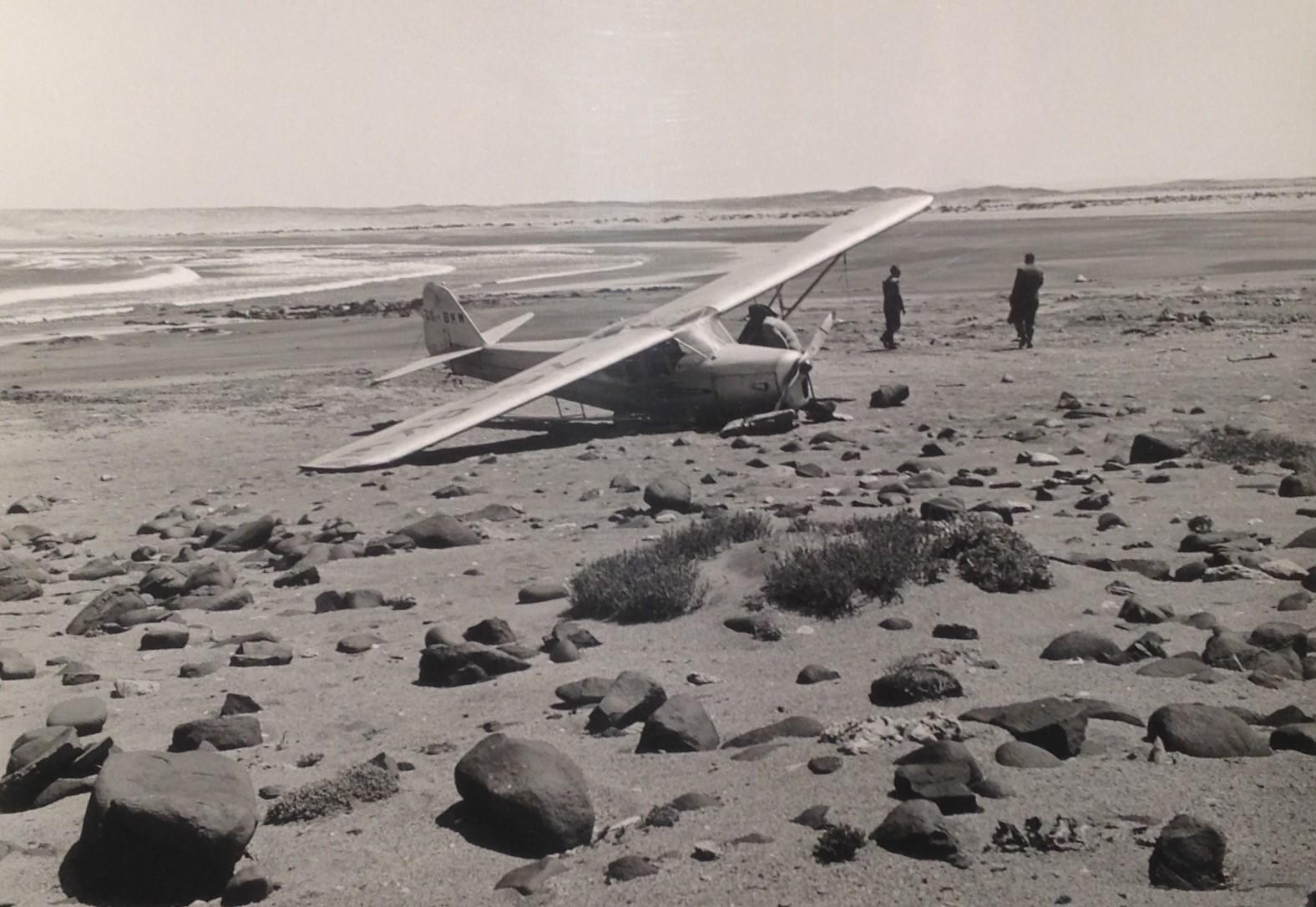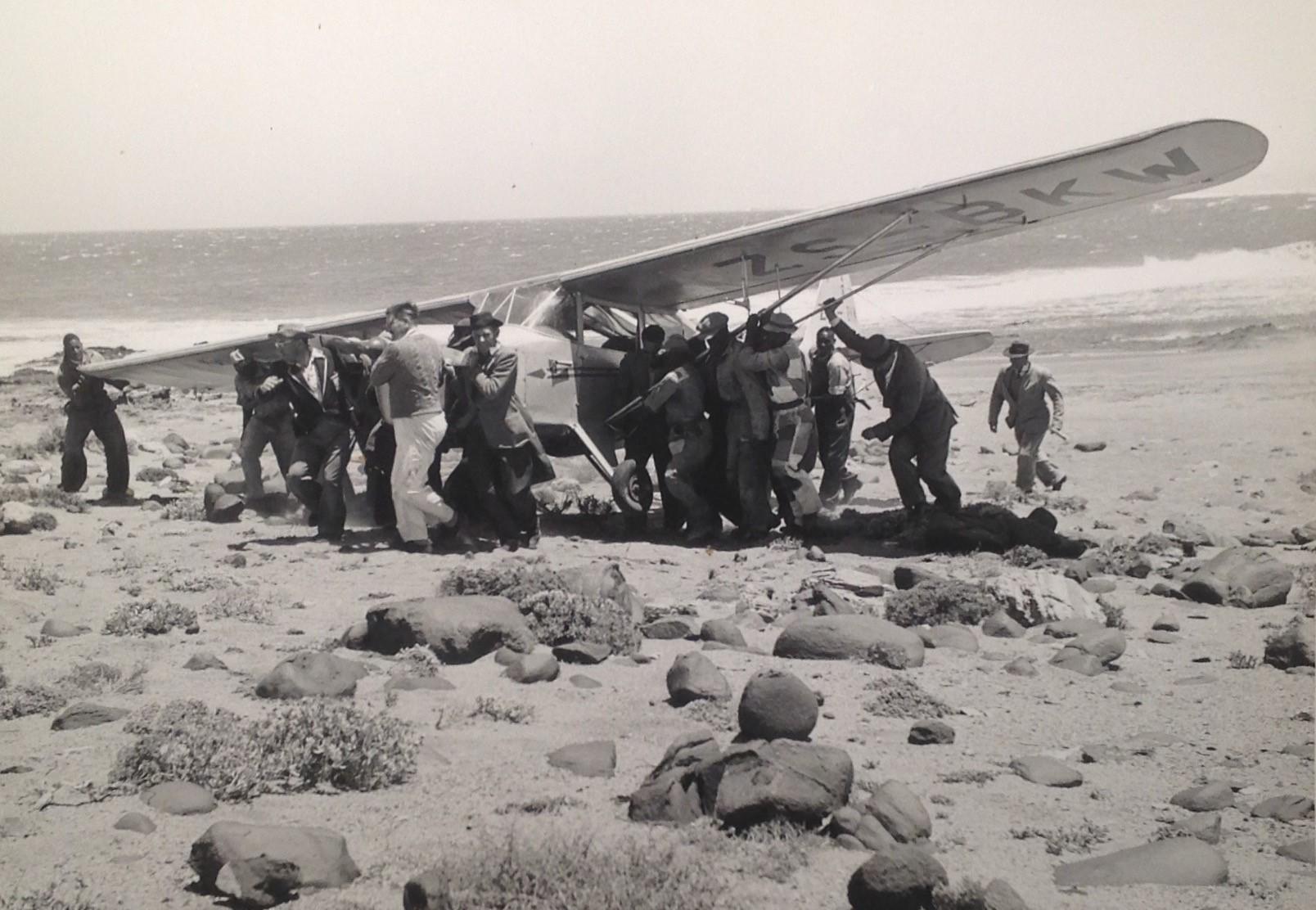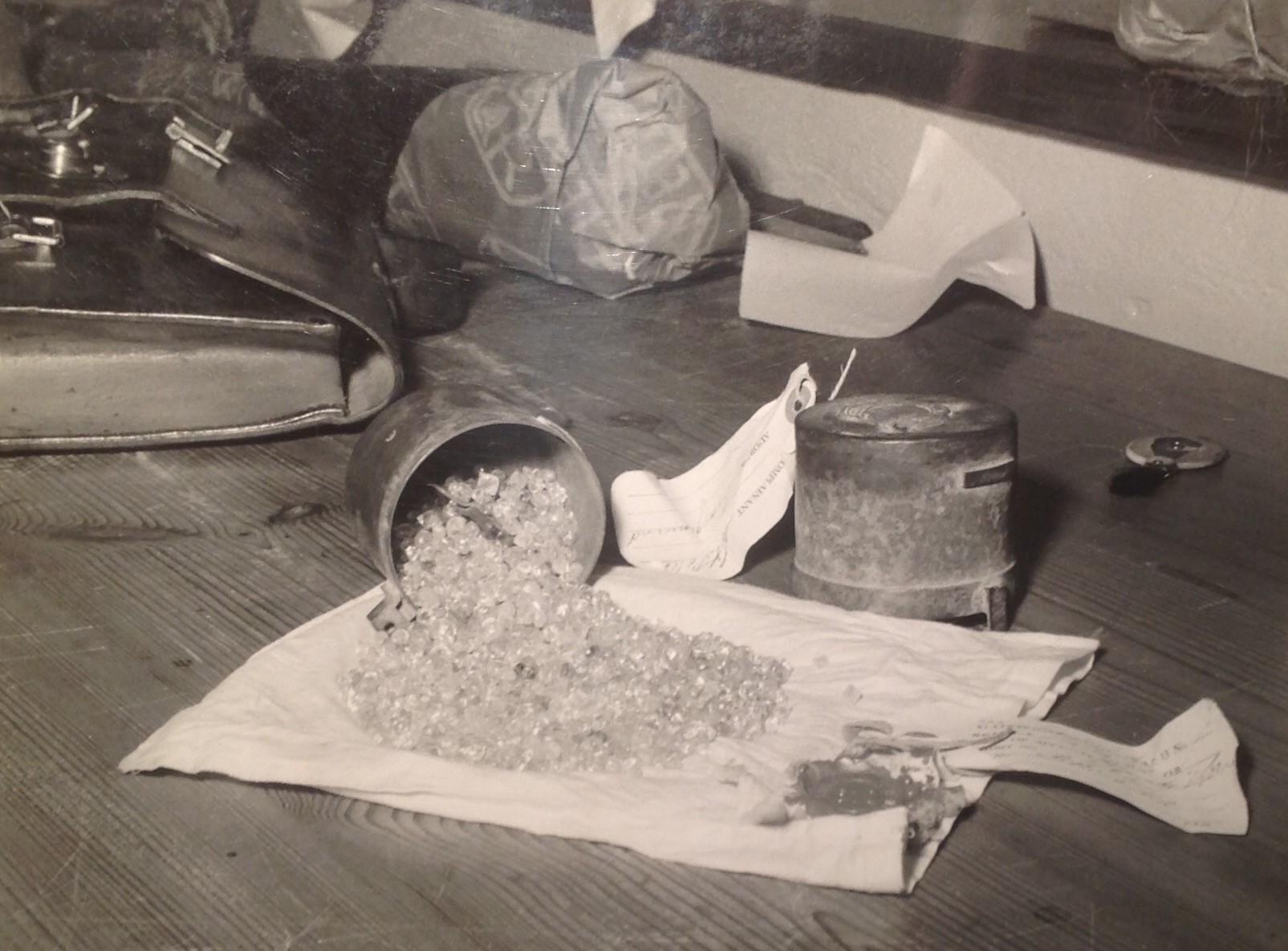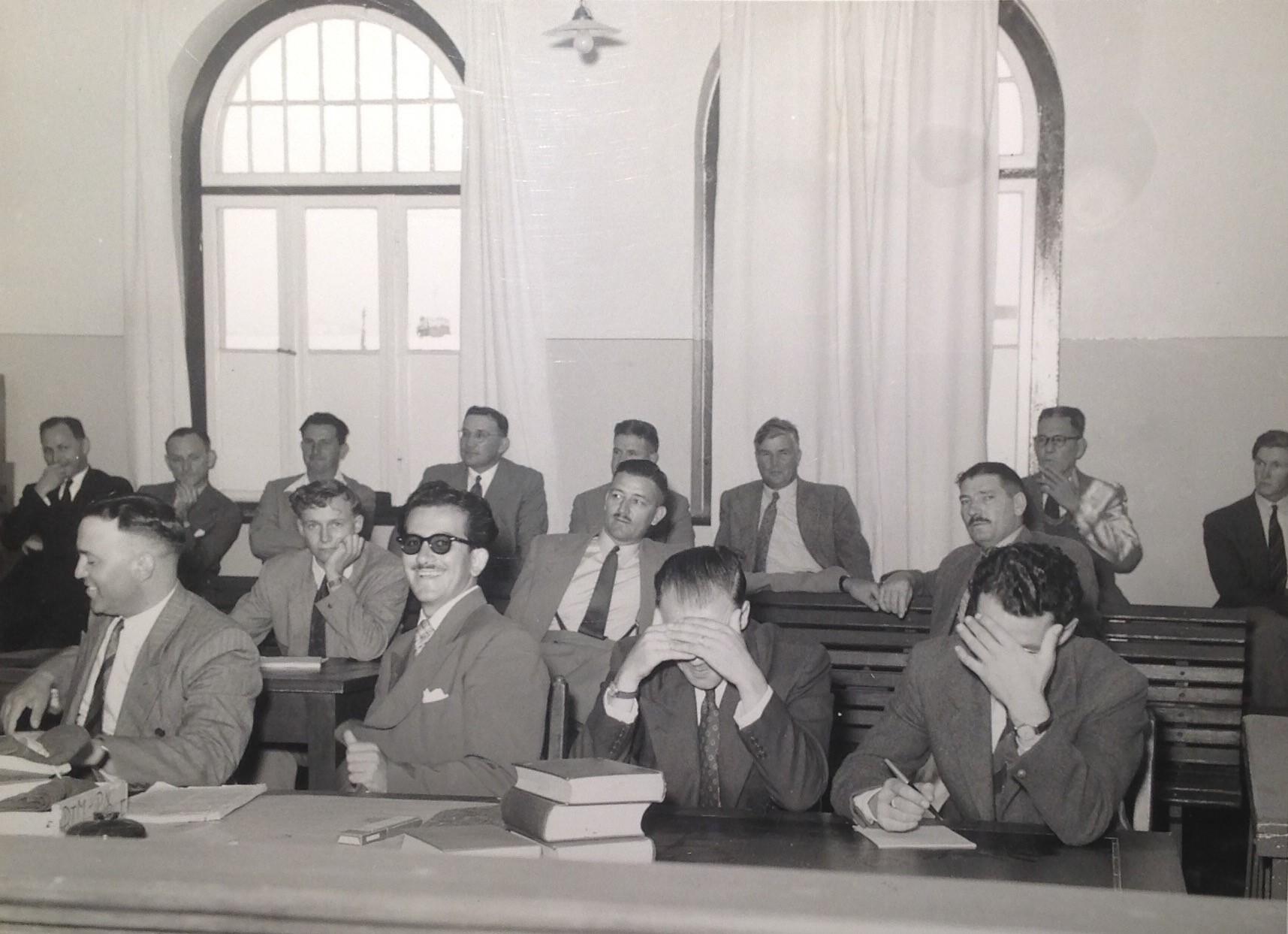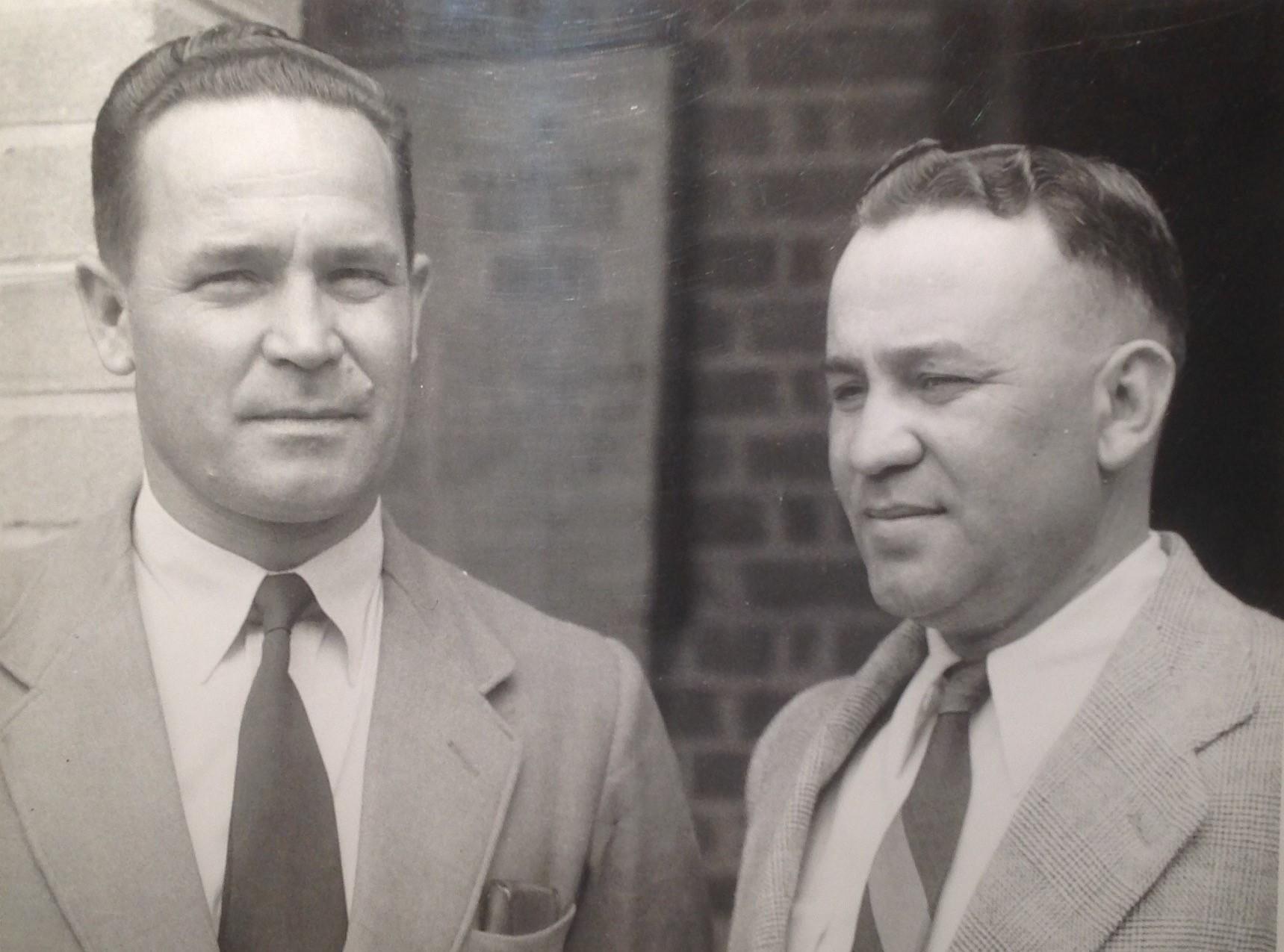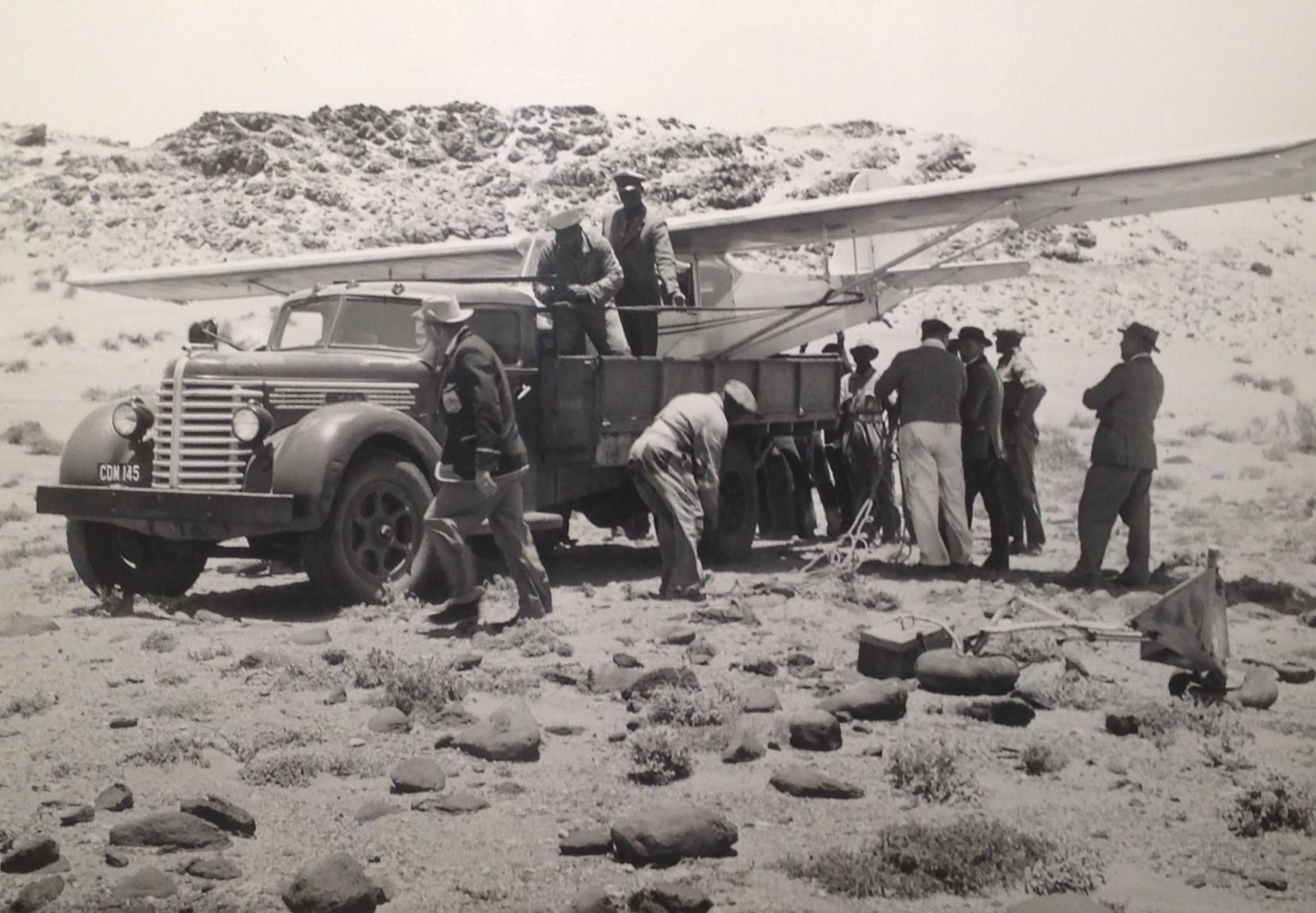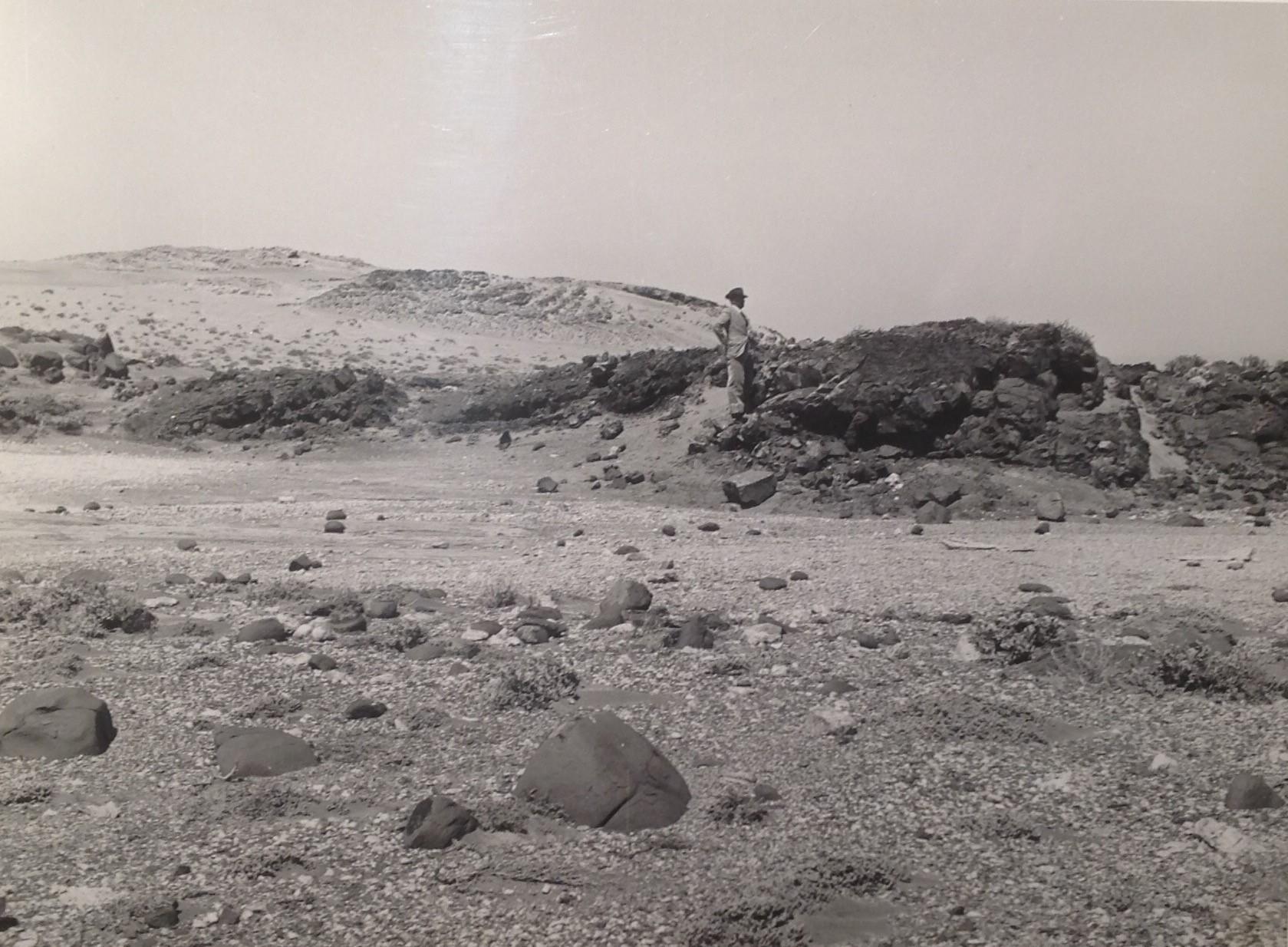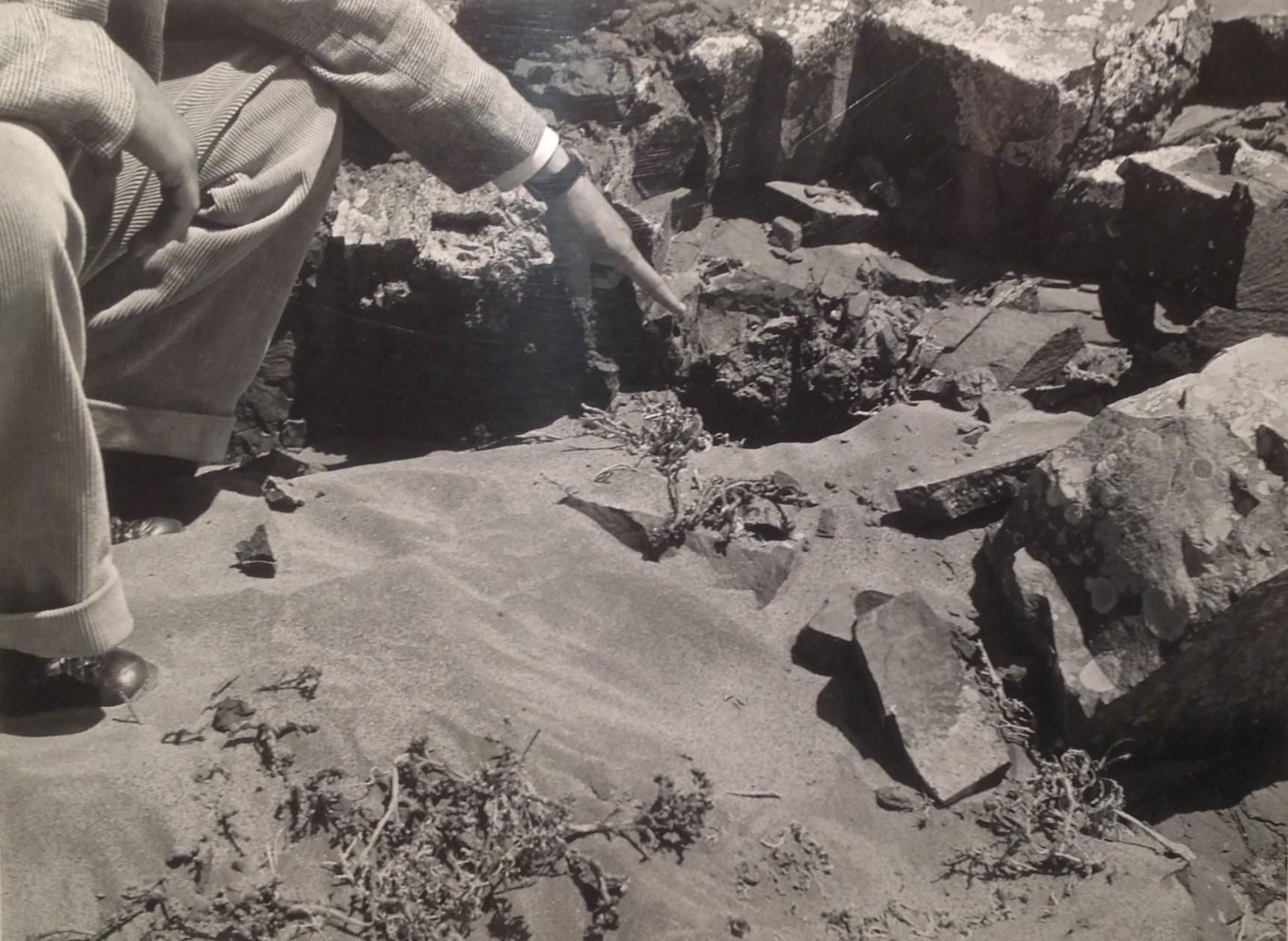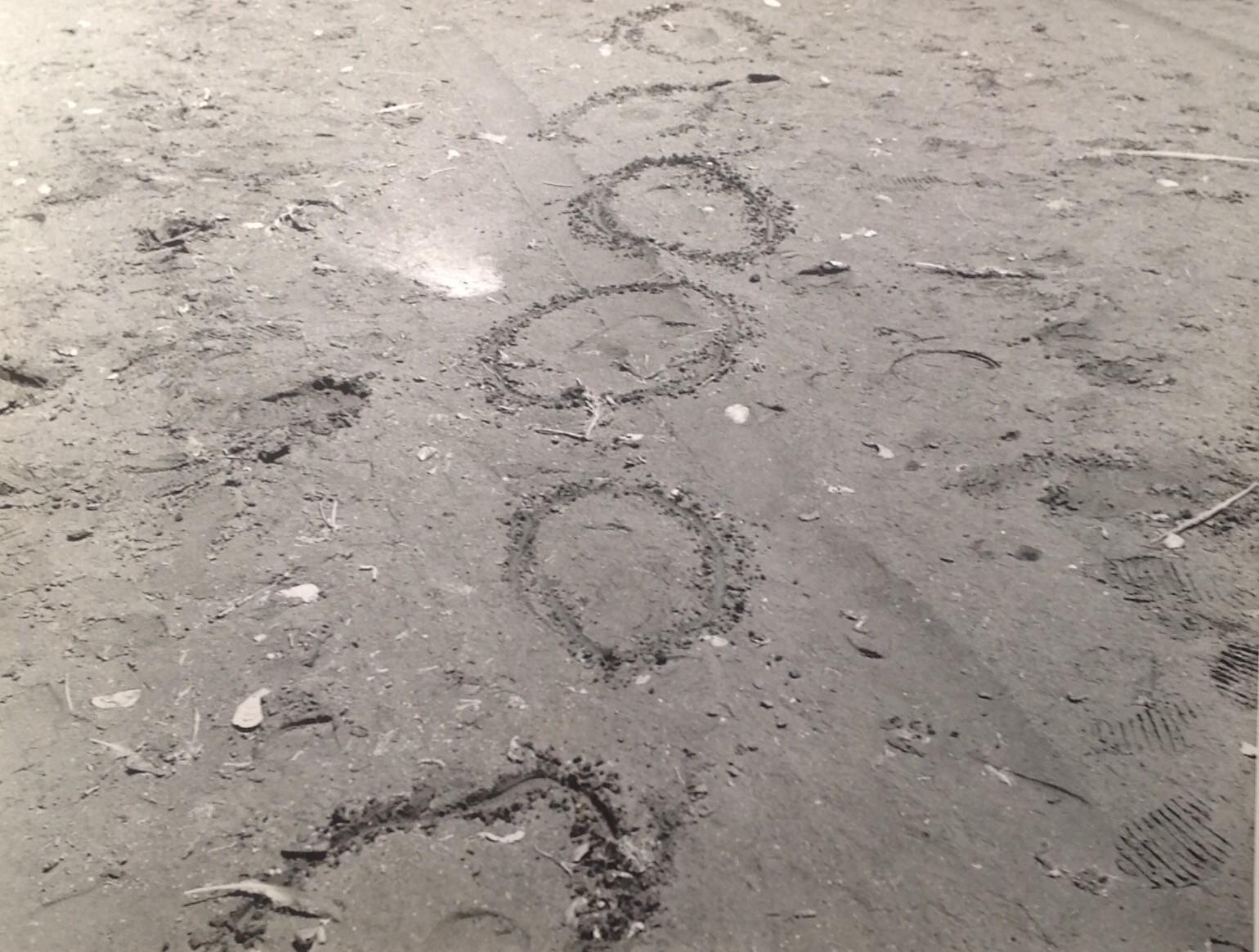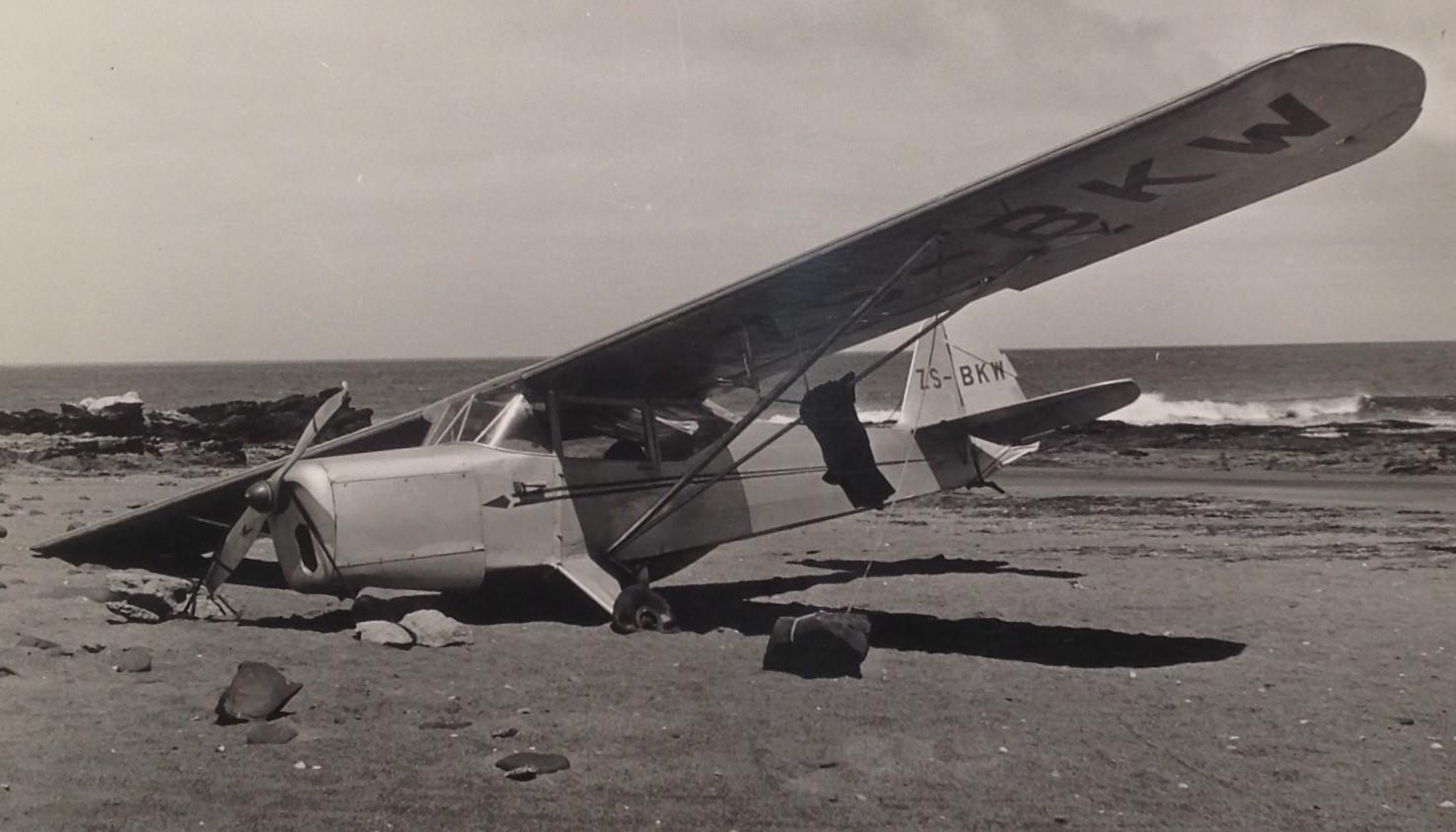
Disclaimer: Any views expressed by individuals and organisations are their own and do not in any way represent the views of The Heritage Portal. If you find any mistakes or historical inaccuracies, please contact the editor.
A Namibian story has it that one morning during the early 1950s two men glided their light aircraft onto a diamond-strewn beach in the Namibian Sperrgebiet (German for no-go or forbidden zone) with the intention of collecting a large amount of diamonds hidden by one of them in rocky outcrops near the beach. On take-off from the beach the aircraft however nose-dived after one of the aircraft’s wheels struck a rock. They were subsequently spotted by the restricted diamond areas’ security personnel and arrested.
Fact or fiction?
Charity store offers up visual evidence
The author is constantly in search of historical South African images. On a recent visit to a Pretoria based charity organisation, the standard question was posed: “Would you have any old South African photographs?”
In majority of instances the response to this would be: “No, we throw them away”, but in this particular instance the charity store volunteer stated that she had some images stashed away somewhere. A few minutes later she appeared with 16 black & white images dating from the early 1950s by the photographer JJ Katzke, all 16,5 x 22cm in size.
The initial attraction was the four photographs of an aircraft stranded on a beach. The rest seemed of little interest, even unrelated to each other. However, when the helpful charity store volunteer stated that she would sell the batch of 16 images for R32 (around $2 or £1.6), the deal was concluded.
Back home, after much googling, the story around these images started to unfold. Soon it became clear that all 16 images relate to a particular story! The constructed story presented here is no doubt an incomplete version of the events in that at the time of publishing this article, a number of questions still remained unanswered (See final observations below).
Although the author’s primary focus has been on South African photographic narratives, this Namibian photographic narrative is simply too good to leave unattended.
These images fall into the categories referred to as “found photographs” and “narrative photography”, a concept the author has written about before. Click here to view 'Use of vintage photographs in narrating visual history - Beitbridge under construction (1928 – 1930)'.
The narrative around a light aircraft on a deserted Namibian beach
The central characters to this story are a former geologist at the De Beers mining company, John Gow Kennedy and an ex-fighter pilot Peter Morrison Lorne.
The diamond smugglers' brazen attempt also had authors such as Geoffrey Jenkind and Ian Fleming (Diamonds are Forever) weaving the unusual event into their respective stories.
Prospecting was still an important part of mine life and prospectors were often sent to lonely outposts with little supervision. Kennedy was sent to Chamais Bay (near Bogenfels) where he set up his tents and was cut off from Oranjemund apart from occasional visits. His responsibility was to count, weigh and keep the diamonds which were recovered by his assistant from the bay. Once a week a senior geologist would come and collect the diamonds, but Kennedy was secretly stockpiling some diamonds and clearly had much time on hand to contemplate his future following the fortunes he was anticipating to make (Corbet, 1989).
Over a two-year period (September 1949 to August 1951), Kennedy collected 2 preserving jars full of selected stones and stashed them under a rocky overhang near the beach at Chamais.
What to do with this stash?
Kennedy decided it was too risky to try and circumvent the mining company’s x-ray system or to bribe the radiographer. He contemplated trying to get a Land Rover through the area without been detected by the mine’s security team. He abandoned this thought and finally decided to hide the diamonds and come in by boat or plane. Having made his decision and having squirreled away his supply of diamonds, he went on annual leave. He arranged for a pilot to fly him into the area and made all the other arrangements, and then resigned (Corbet, 1989).
In order to succeed in his plan, he had to share his secret with an allegedly decorated and knighted ex-fighter pilot Morrison Lorne, who agreed to help Kennedy to recover his squirreled treasure from its hiding place near the beach. Legend has it that Kennedy “recruited” Lorne whilst on leave in Cape Town.
It is not known whether Kennedy flew with Lorne from Cape Town to Lüderitzbucht, but the final phase of their plan kicked into action when they took off from Lüderitzbucht before sunrise on 18 December 1952 (both the time of day and date here differ from other versions) and landed on the Chamais beach at low tide where Kennedy collected his hidden stash.
One unlikely version of this fascinating story suggests that Lorne, prior to take off from the beach, instructed Kennedy to lift the tail of the plane (an Auster taildragger) and run with it for as long as he could to allow the aircraft to build up speed. The thinking was that Kennedy, who would have been left behind, would then later be picked up by the Consolidated Diamond Mine (CDM) security team. Kennedy however allegedly suffered psychological instability from a wartime incident and decided against being left in the dark and misty conditions. He ran with the plane for a short distance as instructed before dumping the tail and attempted to clamber onto the wing of the plane.
Unfortunately for them, in the process of Lorne helping Kennedy into the plane, whilst at the same time attending to the take-off, the front wheel struck a rock and the take-off had to be aborted. The aircraft sustained some damage resulting in Lorne not being able to attempt take-off again.
Diamond smugglers' aircraft on a deserted and rocky beach near Bogenfels. The men visible in the distance are in all probability investigators and mine security employees on the scene after the failed take-off of the aircraft. Considering the number of rocks on the beach, the narrative that one of the aircraft’s wheels struck a rock is a very probable version.
The crashed smugglers' aircraft in the process of being removed from the beach by at least 13 men
The two were later spotted by the CDM security team and taken into custody. They faced trial in Lüderitzbucht during January 1953.
When the men were located by the security team, no diamonds were found on them or in the aircraft which made conviction difficult. Eventually, more evidence was found on 24 December 1952, after the men confessed and showed the investigators where the stash was to be found (Corbet, 1989).
When the two men were brought to court during January 1952, their lawyer argued that the original concession for diamond prospecting extended only to the high water mark on the beach, and since the plane had landed on the seaward side of this demarcation line, the men had not violated the sanctity of the forbidden zone. The De Beers subsidiary, which held the concession, argued that its rights extended to the low water mark and that the men were therefore trespassers.
There were 1400 diamonds, totalling some 2267 carats, valued at around £40 000 at that time (around R22 million in today’s terms)! Kennedy was allegedly sentenced to 9 months of hard labour, while the pilot was sentenced to 6 months! (Corbet, 1989). Another suggestion is that Kennedy was deported, and Lorne received a 9-year sentence and not 9 months.
Diamonds in the court room - Some 1400 diamonds placed in two containers were found a few days after the two smugglers' unsuccessful take-off from the beach in their light aircraft. The value of these diamonds today equates to some R22 million.
An interesting alternative version around the findings of the court, contradicting the above version, suggests that De Beers was surprised and dismayed when the judge accepted the defendants' contention. Not only were both men acquitted but, more far-reaching, De Beers was held not to control legally the rights to the submerged portion of the 200-mile long forbidden zone. This version however needs to be confirmed by studying the court ruling.
The court case details are as follows:
Lüderitzbucht: Case 9/1952 - Rex versus John Gow Kennedy; Peter Morrison Lorne; contravening section 22 of proclamation 17 of 39 (read with section 27).
Court proceedings taking place in Lüderitzbucht. It is assumed that the men covering their faces may have been the defendants in the case namely, Kennedy and Lorne. The two men on the left are in all probability the duo’s defence attorneys. Of interest is that the proceedings only seem to have been attended by white males.
Unknown parties in attendance during the court proceedings. It is assumed that the gentleman with the glasses is the defence attorney. He also appears in the image above (second from left). The gentleman (a police officer) on his left is assumed to be a witness for the defendants.
Two unknown parties outside the court. The gentleman on the right also features in the image above of the men in the court room (seated next to gentleman with glasses). There is a remote possibility that these individuals may also have been be Kennedy and Lorne (unlikely though)
Oranjemund and the Consolidated Diamond Mining company
The Namibian town Oranjemund, at the mouth of the Orange River, owes its existence to diamonds. The town was established during 1936, following Hans Merensky's discovery of significant alluvial diamond deposits on the north bank of the Orange River and the adjacent northern coastline.
So great was its wealth, Oranjemund replaced Kolmanskop as the CDM headquarters during 1944.
Consolidated Diamond Mines of South West Africa, Ltd. (a subsidiary of De Beers Consolidated Mines, Ltd.) was renamed to the Namdeb Diamond Corporation during 1994 with equal partnership between the Namibian government and De Beers.
During 2004 the Namibian government announced plans to establish the Sperrgebiet as a national park with the intent of attracting tourists. The Sperrgebiet National Park, covering some 26 000 square km, was gazetted in December 2008 and formally opened during February 2009.
About the light aircraft
The aircraft, with registration number ZS-BKW, is described on the Aviation Safety Network database as an Auster J/1 – Autocrat which was written off after it crashed at Bogenfels on 21 December 1952. The details captured for this incident incorrectly state that there was only one occupant in the aircraft at the time of the accident.
Bogenfels is situated between Lüderitzbucht (to the north) and Oranjemund (to the south) in the restricted diamond area. Chamais Bay, where the diamonds were hidden, in turn is located just south of Bogenfels.
Following the accident, the light aircraft was lifted by at least 13 men onto a truck that belonged to CDM and transported to the Central Field workshop based in Oranjemund where it was left to deteriorate.
The crashed smugglers' aircraft loaded onto a truck that belonged to Consolidated Diamond Mines (CDM). The aircraft was taken to Oranjemund.
The Auster J/1 Autocrat light aircrafts became the first post war civil aircrafts to go into production. Over 400 were built and sold for just over £1,000 each at the time. This aircraft was the forerunner of prolific and diverse brands of light aircraft that were sold worldwide to both military and civilian customers. This model was initially manufactured under the name Taylorcraft. The Auster company refer to their aircraft as “Eyes of the Army”.
Photographs presented as evidence in a court of law
Some of the 16 photographs obtained have both alphabetical and numerical numbering pencilled in on the back, suggesting that the images were used as photographic evidence during the court proceedings. The possibility exists that there may have been more than the 16 images produced of the illicit event. The images obtained were however sufficient in order to put part of the puzzle together around the event.
The use of photographic evidence has become an all-important and accepted branch of the law of evidence. The use of photographic evidence in a court of law is largely based on explanatory or illustrative evidence. The primary use thereof is to assist the court to support the testimony presented by witnesses.
Even as early as the early 1900s, the science of photography has been described as being of great assistance to legal teams when preparing and presenting cases.
It is further recorded that the following was stated in an American court (also early 1900s):
We cannot conceive of a more impartial and truthful witness than the sun, as its light stamps and seals the similitude of the object on the photograph put before the jury; it would be more accurate than the memory of witnesses…. the purpose of evidence is to show the truth…
Rocky outcrop in the distance where diamonds were hidden (with the beach behind the photographer) – a few 100 metres away from where the light aircraft crashed after an unsuccessful take-off.
A security official or investigator points out the exact spot where the hidden diamonds were eventually found in the rocky outcrop as can be seen from a distance in the above image.
Footprints on the beach as circled by security officials or investigators. It is not clear as to what the relevance of this footprints are – Do they possibly relate to footprints from the aircraft towards the rocky outcrop?
About the photographer – James Julius Katzke
Little is known about Julius Katzke. He was born on 22 January 1920 and passed away on 25 May 2007, aged 87. He seems to have resided in Stilbaai (Riversdale) at the time of his death.
Julius would have been 32 years old when the photographs included in this article were captured. Although the back of the images state: “Copyright – Whenever reproduced this photo must be acknowledged to JJ Katzke”, it is assumed that he took these images as an employee of CDM at the time.
During February 1956, Julius is recorded as the appointed technical advisor for the Oranjemund Photographic Club. It is unlikely that he was a fulltime photographer in that it has been suggested that he held a “fairly” mid-level post in the CDM survey department.
Julius has further been described as a mover, shaker and an ebullient character, much liked by all and a magnet for women. He seemingly was a great host and entertainer who loved theatricals and played leading roles in many of the Oranjemund Players’ productions.
Katzke initiated the building of a yacht club at the pan in Oranjemund. This idea initially sounded unachievable until Katzke pointed out that with minimal earthworks and a pumping station that the pan could be enlarged and the water level deepened. After some objection and with much creativity, the pan was converted into a yacht club. The pan soon churned with weekend sailors, water skiers and happily splashing kids.
Final observations
Although the story turns out to be fact, some aspects of this diamond smuggling story have clearly been fictionalised over the years in that subtle differences exist in the various narratives, such as:
- That the duo landed on the beach early one morning, yet another version states that they landed in the dark of the night;
- That the diamonds were hidden in a toilet cistern, yet the more probable version (as per photographic evidence) is that they were hidden in a rocky outcrop on the beach;
- The dates between the various stories/records around when the incident occurred varies by three days (between 18 December and 21 December 1952)
- The aircraft struck a rock on take-off versus running into a prospectors’ trench
- That the duo was acquitted following the legal proceedings versus them having received a sanction of some sort.
Some curious questions around the photographs are pertinent:
- How did it come about that the photographs included in this article ended up in a charity store in greater Pretoria?
- Were they in possession of the photographer (who passed away in Stilbaai during 2007), if so, how did they end up in Pretoria? Or;
- Were the photographs in possession of the smuggling duo’s defending attorney (whose name has not been determined to date)?
- Who are all the unidentified parties on the images – most of whom would be long-gone?
The images included in this article confirm that photographic evidence is critical during criminal proceedings and assists us in creating a visual context to a story.
The burning question remains – What happened to Kennedy and Lorne post their failed attempt? Should readers be able to add any additional information to the above narrative, they are requested to email the author at Carol.Hardijzer@webmail.co.za
Main image: 1. The crashed Auster aircraft on a beach near Bogenfels following an unsuccessful take off after smugglers retrieved nearly 1400 hidden diamonds from a rocky outcrop near the beach. Note how the aircraft wing and nose have been tied to rocks in order to prevent unnecessary movement. Also note the damaged tyre and propeller
About the author: Carol is passionate about South African Photographica – anything and everything to do with the history of photography. He not only collects anything relating to photography, but also extensively conducts research in this field. He has published a variety of articles on this topic and assisted a publisher and fellow researchers in the field. Of particular interest to Carol are historical South African photographs. He is conducting research on South African based photographers from before 1910. Carol has one of the largest private photographic collections in South Africa.
Sources
- Auster aircraft history (austerhg.org - Extracted 28 January 2021)
- Aviation Safety Network information on aircraft ZS-BKW – ASN Wikibase occurrence number 18231 (aviation-safety.net - Extracted 28 January 2021)
- Barron, R. (2008). Things I remember about Oranjemund. The diamond smugglers plane (Oranjemundonline.com – 28 October 2008)
- Consolidated Diamond Mines of South West Africa (Britannica.com extracted 31 January 2021)
- Corbett, A. (1989). Diamond beaches: A history of Oranjemund 1928-1989. Cape Town
- Darné, A. (2007). Things I remember about Oranjemund. Security department: Diamond theft (Oranjemundonline.com – 30 September 2007)
- Epstein, E.J. (nd). The diamond invention: Chapter 19 – The war against competitors. (edwardjayepstein.com)
- Kenner, S. (1905). Photographs as evidence. Central Law Journal 406, May 26, 1905 (chnm.gmu.edu/aq/photos)
- Molloy, B. (2009). What grabbed me in the news today. (Oranjemundonline.com – 21 February 2009)
- Molloy, B. (2010). Things I remember about Oranjemund. Oranjemund’ s first resident dentist (Oranjemundonline.com – 23 July 2010)
Comments will load below. If for any reason none appear click here for some troubleshooting tips. If you would like to post a comment and need instructions click here.

